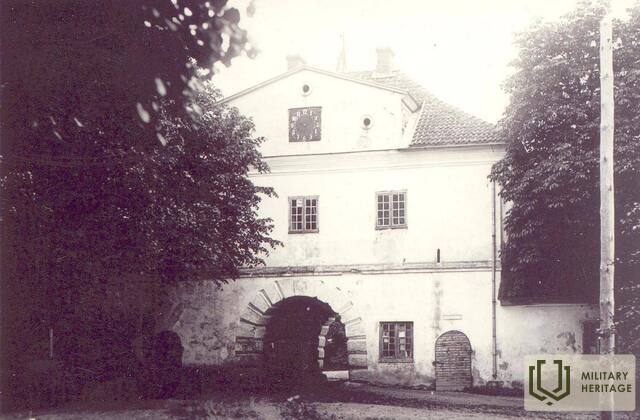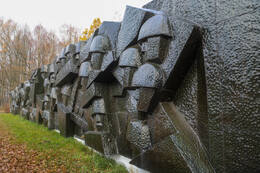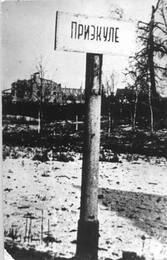Devyniolikmetės Raisos Ahmedejevos pasakojimas apie žvalgybinį mūšį 1945 m. vasario 14 d. netoli Priekulės
Baškirijoje gimusio Raudonosios armijos kareivio Raiso Ahmadejevo (19 m.) pasakojimas apie sovietų armijos pasiruošimą puolimui prieš Priekulę ir žvalgybinį mūšį Piekulėje 1945 m. vasario 14 d.
„Išaušo 1945-ųjų vasaris. Orai buvo permainingi, kaip dažnai būna Baltijos šalyse. Ryte šalta, dieną snigo, vakare prasidėjo lietus, bet naktį vėl šąla.
Mūsų 267-oji Raudonosios vėliavos gvardijos šaulių divizija, apdovanota Suvorovo ordinu, buvo įsikūrusi kiek daugiau nei 1 km į pietvakarius nuo Priekulės, kur anksčiau buvo vykdomi durpių kasimo darbai. Ten buvo įrengta mūsų armijos fronto linija. Iš ten 1945 m. vasario 20 d. prasidėjo puolimas prieš Priekulėje dislokuotas vokiečių pajėgas. Ši vieta laikinai tapo mūsų – šaulių – namais. Artilerija ir kiti armijos daliniai buvo dislokuoti už mūsų, ant kalvos miške. Ten buvo lengviau iškasti slėptuves, įrengti bunkerius. Mums, pėstininkams, palankiausia vieta buvo kaip tik durpyne. Tuo metu tarnavau 848-ajame šaulių pulke.
Vokiečių gynybos linija zigzago raštu driekėsi aukštumoje nuo mokyklos daubos iki miesto geležinkelio stoties. Prieš vokiečius buvome kaip ant delno. Sunkiausia dienos dalis buvo ją įveikti, nes negalėjome pakelti galvų iš apkasų, nebent norėjome gauti kulką į galvą. Vokiečiai nuolat šaudė į mūsų pozicijas skeveldromis, kurios sprogo tiesiai virš mūsų galvų.
Apkasai negalėjo būti gilesni nei 1 m arba sapierio kastuvo gylio, nes vanduo kaupdavosi giliau. Mes atsargiai klojome aplink juos žemę iš apkasų, suformuodami nedidelę apsauginę sienelę. Kiek įmanoma, ją uždengėme sniegu. Apkasų žemę uždengėme alksnio šakomis. Puikiai prisimenu, kad netoli mano pozicijos buvo nedidelis alksnio miškas. Apkasus galėjome kasti tik naktį ir labai sunkiai, nes netoli mūsų apkasų priešo sviediniai buvo padegę durpes. Jos degė. Viena vertus, gerai – galėjome prie jų prisėlinti sušilti. Kita vertus, labai pavojinga, nes vokiečiai degančių durpių šviesoje galėjo nušauti drąsuolį.
Ypač pavojingas buvo žygis ieškoti maisto iš arčiau kelio esančios vietos. Valgydavome tik 2 kartus per dieną: labai anksti pusryčiaudavome, kol dar buvo tamsu, ir labai vėlai pietaudavome, kai jau buvo tamsu. Dažnai pasitaikydavo, kad maisto nešėjas patekdavo į ugnį ir arba susidorodavo su užduotimi, arba būdavo nušaunamas. Taip pat pasitaikydavo, kad maistą nešęs kareivis, bėgdamas nuo ugnies, suklupdavo, ir maistas iš puodo išsipylė ant žemės. Tada likome be maisto.
Kai norėdavome valgyti, daug galvodavome, ką daryti? Mes ir išsiaiškinome! Netoli mūsų pozicijos mėtėsi nušauti arkliai. Prisėlindavome prie jų, sapierio kastuvu nupjaudavome ar nukapodavome gabalėlį. Tada uždėdavome jį ant lanksčios alksnio lazdos ir nušliauždavome prie degančių durpių, kur galėdavome jį iškepti. Jei pasisekdavo, kad nebūdavo šaudoma, galėdavome į puodą įdėti sniego, jį ištirpdyti ir išvirti arklienos gabalėlį. Bet tik išvirkite, viduje jis vis tiek likdavo žalias. Bet tai gerai. Kai norisi valgyti, galima ir taip valgyti.
Retkarčiais mūsų kareiviai eidavo į žvalgybą. Jiems taip pat buvo pavesta sugauti vokietį, kad gautų daugiau informacijos apie vokiečių gynybines pozicijas. Todėl tokius kalinius vadinome „liežuviais“, o žvalgai persekiojo „liežuvį“. Tuo pačiu metu vokiečių snaiperiai su optiniais taikikliais ir galingais prožektoriais skenavo mūsų pozicijas ir šaudė į viską, kas bent atrodė kaip judantis žmogus. Retkarčiais danguje buvo galima pamatyti ir oro balioną, iš kurio vokiečiai tyrinėjo mūsų gynybines pozicijas. Mūsų artileristai dažnai šaudydavo į šiuos balionus ir jų pilotus.
Aviacija dalyvavo mūšiuose netoli Liepojos, virš uosto. Mes tai žinojome, nes visur skambėjo šūksniai „Į Liepoją! Už Liepoją!“. Tai buvo pagrindinė mūsų mūšių kryptis – pagrindinis tikslas.
Naktį vykdavo komjaunimo susirinkimai, kuriuose, be komjaunimo klausimų aptarimo, kareiviai buvo ir psichologiškai ruošiami mūšiui. Drausmės pažeidimų nebuvo, kareiviai buvo labai drausmingi. Tačiau tai suprantama, nes drausmės pažeidimai galėjo kainuoti gyvybes.
Reguliariai gaudavome laiškų iš namų. Taip pat buvo siuntų iš visiškai nepažįstamų žmonių – kojinių, batų, nosinaičių, tabako ir kitų kareiviui naudingų daiktų. Labai džiaugėmės šiomis siuntomis, nes jos atkeliavo iš ten – iš namų, iš už fronto. Dėl jų buvome pasiruošę kovoti tiek, kiek reikės, kad kuo greičiau grįžtume namo.
Taip gyvenome iki 1945 m. vasario 20 d. Kiekvieną dieną stebėjome Priekulius ir jų apylinkes, laukėme įsakymo stoti į mūšį.“
Vokiečiai taip pat buvo paruošę gynybines pozicijas. Tik jie turėjo daugiau laiko šiai užduočiai atlikti, artėjant fronto linijai. Galbūt todėl jų gynybinės pozicijos priminė neįveikiamą tvirtovę.
Beveik kiekvienas iš akmens ar plytų pastatytas namas Priekulės mieste ir užmiestyje buvo pritaikytas tiek slėpimuisi, tiek šaudymui. Dauguma šių namų taip pat turėjo rūsius, kuriuose buvo galima slėptis nuo oro antskrydžių, ilsėtis, tvarstyti sužeistuosius, laikyti ginklus, šaudmenis ir maistą. Kadangi gana lygioje Priekulės vietovėje tokių kaimo sodybų buvo nemažai, patekti į šiuos įtvirtintus vokiečių gynybos sistemos taškus buvo itin sunku. Jei prie namų buvo miškas, kalva ar krūmai, tai nieko. Bet taip... per atvirą lauką...
Netoli daugelio kaimo sodybų vokiečiai buvo panaudoję neįprastą gynybos sistemos elementą – iki pat vamzdžio žemėje įkastus tankus. Iš čia optiniais prietaisais buvo galima apžvelgti gana toli esančią aplinką, o iš čia buvo galima šaudyti bet kuria kryptimi, nes tankų vamzdžius buvo galima pasukti. Taigi, žemėje paslėptus tankus buvo gana sunku pastebėti. Juos buvo galima sunaikinti tik aviacijos bombomis arba didelio kalibro ginklais, kuriems katastrofiškai trūko amunicijos. Todėl žemėje užkastos mašinos buvo labai patikima priedanga viskam ir visiems, kas jose buvo. Kai kuriose Priekulės rajono vietose vis dar galima pamatyti kvadratines, iš dalies užblokuotas duobes. Kai kurios iš jų buvo ne šarvuočiai, o tankų pozicijos.
Priekulėje visi miesto mūriniai pastatai buvo paversti kruopščiai įtvirtintais gynybos sistemos atramos punktais: stotis, bažnyčia, plytų krosnis, ketaus liejykla (buvusios pieninės vietoje), grūdų sandėliavimo punktas, Švedų vartai ir Korfu namai. Paskutinio karo metu veikė mokykla, tačiau artėjant fronto linijai čia buvo įrengta vokiečių ligoninė. Rajone tarp Rainio, Tirgus, Galveno ir Ķieģeļu gatvių stovėjo dar keli mūriniai pastatai su keliais aukštais. Tik jie buvo sunaikinti per oro antskrydžius jau 1944 m.
Liuteronų bažnyčia yra aukščiausias Priekulės taškas. Net ir karo metu iš jos buvo galima matyti gana plačią miesto teritoriją, todėl bažnyčia buvo paversta pagrindiniu vietovės stebėjimo ir kontrolės punktu. Naktį bažnyčios bokšte buvo įjungiamas galingas prožektorius, kuris, judėdamas, savo šviesos spinduliu galėjo apšviesti bet kurią miesto vietą, todėl nepastebėtam priartėti prie miesto buvo itin sunku. Bažnyčioje taip pat buvo įrengtas snaiperių punktas, kad kiekvienas ir viskas, artėjantys prie Priekulės, būtų nedelsiant sunaikinami.
Visi pagrindiniai vokiečių gynybos sistemos taškai, tiek miesto viduje, tiek už jo ribų, buvo sujungti apkasais. Kareiviai galėjo jais judėti gana patogiai ir saugiai. Apkasai buvo itin svarbūs manevravimui mūšių metu, ypač gana lygiame Priekulės apylinkių reljefe. Iki Priekulės ir jos apylinkių išvadavimo mūšių vokiečiai buvo sukūrę tris gynybos linijas, kurių kiekviena buvo apie 7 km pločio. Kiekvienoje iš jų buvo 1–3 apkasai, kurie jungė pagrindinius įtvirtinimų taškus – kai kuriuos pastatus ir statinius virš žemės arba po žeme.
Absoliučiai visi svarbūs keliai buvo užminuoti, vietomis sugriauti arba užblokuoti akmenimis ir nuvirtusiais medžiais. Pagrindiniai privažiavimai prie visų gynybos linijų ir jų įtvirtintų atramos taškų taip pat buvo užminuoti, uždengti spygliuotos vielos tvoromis ir grioviais. Miško takai taip pat buvo užblokuoti nuvirtusiais medžiais. Virgos upė su gana stačiais krantais buvo natūralus vokiečių gynybos sistemos elementas, sunkiai įveikiamas sunkiajai karinei technikai.
Visą Priekulės apylinkes tarsi tinklas dengė apkasų sistema, tinkama pavieniams kareiviams ir jų nedidelėms grupėms. Daugelis šių vietų vis dar aiškiai matomos žmonių kasdieniame gyvenime nenaudojamose vietose – miškuose, miško pakraščiuose ir krūmynuose.“
leishmalite.lv
Jūsų komentarai
Susijusi laiko juosta
Susijusios vietos
Priekulės karių kapinių memorialinis ansamblis
Priekulės karių kapinių memorialinis ansamblis yra Liepojos-Priekulės-Skodos kelyje ir yra didžiausia Antrojo pasaulinio karo sovietų karių laidojimo vieta Baltijos šalyse. Čia palaidota daugiau nei 23 000 sovietų karių. Operacija „Priekulė“ buvo vienas įnirtingiausių mūšių Kuržemės tvirtovėje, vykęs nuo 1944 m. spalio iki 1945 m. vasario 21 d. Priekulės mūšis 1945 m. vasarį truko septynias dienas ir naktis be perstojo ir pareikalavo daug aukų abiejose pusėse. Iki Priekulės karių kapinių pavertimo memorialu čia buvo pastatytas paskutinis iškilaus latvių skulptoriaus K. Zālės (1888–1942) paminklas, skirtas Alojos nepriklausomybės kovoms atminti. Nuo 1974 iki 1984 m. 8 ha Priekulės karių kapinės buvo paverstos memorialiniu ansambliu, skirtu Antrojo pasaulinio karo žuvusiems. Jį suprojektavo skulptorius P. Zaļkalne, architektai A. Zoldners ir E. Salguss bei dendrologas A. Lasis.
Memorialo centre stovi 12 m aukščio statula, vadinama „Tėvyne“, o žuvusiųjų vardai iškalti granito plokštėse. Iki Latvijos nepriklausomybės atgavimo Pergalės diena buvo plačiai švenčiama kasmet gegužės 9 d.









Dar viena gera istorija, paremta kario patirtimi iš šios Latvijos vietovės.